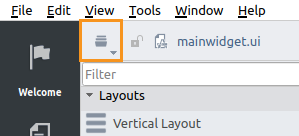Dialogs
Dialogs

A dialog is a popup window that shows on top of the main window contents.
Dialogs are typically opened using Popup Dialog Buttons, which load a separate form (.ui file) dynamically when clicked.
For detailed information about dialog loading and configuration, see the Dialog Framework.
Creating Dialog Files
In Design mode, you can create and edit dialog forms just like any other form in your project.
To create a new dialog form:
- Open the file wizard using File > New File... or the dedicated button in the toolbar.
- In the wizard, select Qt > Qt Designer Form.
- On the next page, choose CDPBaseDialog under Custom Widgets.

Selecting Dialog Files
Use the following Design mode button to open existing files:

After opening the file, it is also selectable in the file selector list next to the button.
This list always shows the name of the currently displayed form.
Dialog Configurations
The Open Bridge template, available from the file wizard, includes several examples of dialog configurations, as shown below:

- Floating panel: Anchored to a top menu button, useful for theme or settings panels.
- Floating submenu: A checkable menu button that opens a submenu dialog with items that forward signals using UI Signal Bridge.
- Standard dialog: A regular dialog shown above the main window content, modal or non-modal.
These and other configurations, such as settings dialogs and reusable dialogs, are discussed in the Dialog Framework.
Get started with CDP Studio today
Let us help you take your great ideas and turn them into the products your customer will love.